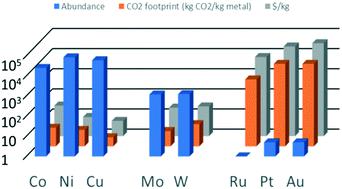当前位置:
X-MOL 学术
›
Catal. Sci. Technol.
›
论文详情
Our official English website, www.x-mol.net, welcomes your feedback! (Note: you will need to create a separate account there.)
Molybdenum and tungsten carbides can shine too
Catalysis Science & Technology ( IF 5 ) Pub Date : 2020-09-07 , DOI: 10.1039/d0cy01420f M. Führer 1, 2, 3, 4 , T. van Haasterecht 1, 2, 3, 4 , J. H. Bitter 1, 2, 3, 4
Catalysis Science & Technology ( IF 5 ) Pub Date : 2020-09-07 , DOI: 10.1039/d0cy01420f M. Führer 1, 2, 3, 4 , T. van Haasterecht 1, 2, 3, 4 , J. H. Bitter 1, 2, 3, 4
Affiliation

|
In this perspective, we argue that carbides of transition metals such as molybdenum and tungsten hold great potential for the catalytic conversions of future feedstocks due to their ability to remain active in the presence of impurities in the feedstock. The presence of N and S impurities, found in increasing amounts in fossil-based feedstocks and also in new renewable feedstocks (such as biomass) may cause the carbides to convert to their respective nitrides or sulphides. These phases are catalytically active for similar reactions to the carbides and so these impurities would not lead to complete catalyst deactivation as they do for noble metal catalysts. Establishing the full potential of transition metal carbides as catalysts requires studies that use real feedstocks to look into the role of heteroatoms during the processing of fossil and novel feedstocks.
中文翻译:

钼和碳化钨也可以发光
从这个角度出发,我们认为,过渡金属的碳化物(例如钼和钨)在未来原料的催化转化方面具有巨大潜力,因为它们在原料中存在杂质的情况下仍具有活性。在基于化石的原料中以及在新的可再生原料(例如生物质)中发现的N和S杂质含量越来越高,可能会导致碳化物转化为其各自的氮化物或硫化物。这些相对于与碳化物的相似反应具有催化活性,因此这些杂质不会像贵金属催化剂那样导致催化剂完全失活。
更新日期:2020-09-21
中文翻译:

钼和碳化钨也可以发光
从这个角度出发,我们认为,过渡金属的碳化物(例如钼和钨)在未来原料的催化转化方面具有巨大潜力,因为它们在原料中存在杂质的情况下仍具有活性。在基于化石的原料中以及在新的可再生原料(例如生物质)中发现的N和S杂质含量越来越高,可能会导致碳化物转化为其各自的氮化物或硫化物。这些相对于与碳化物的相似反应具有催化活性,因此这些杂质不会像贵金属催化剂那样导致催化剂完全失活。


























 京公网安备 11010802027423号
京公网安备 11010802027423号